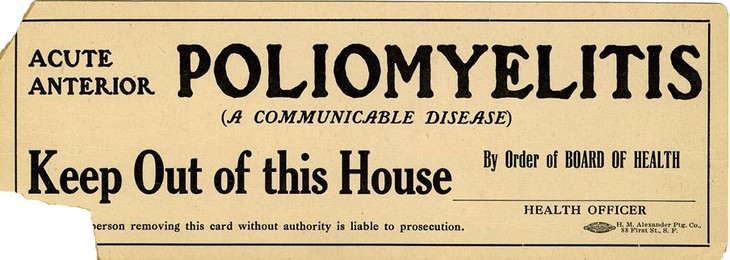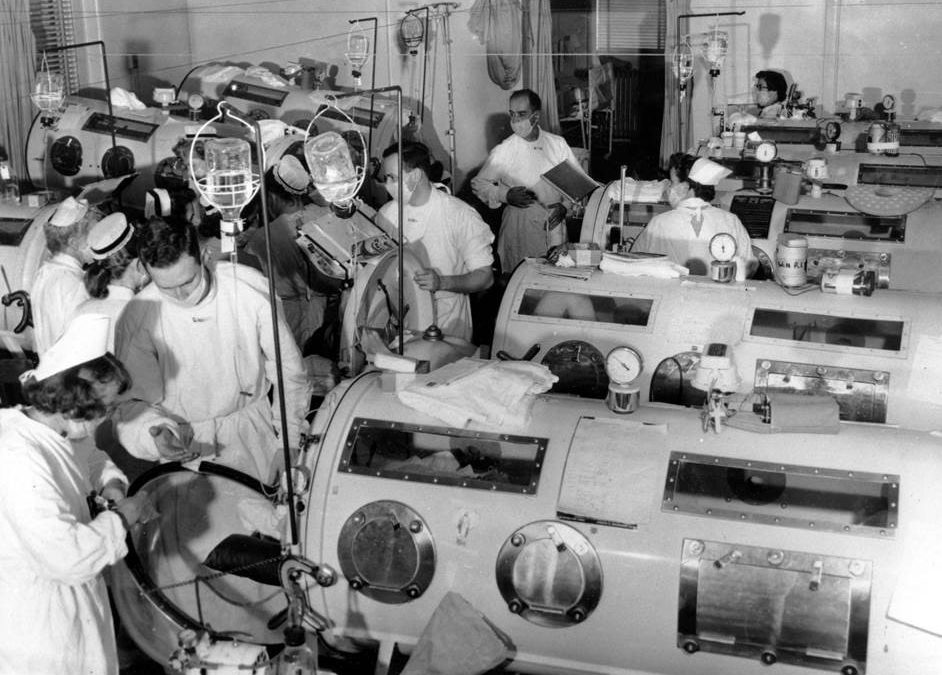Here is a guest blog from Helen Gelly, MD. I could not have said it better. — Caroline
Bright, intelligent, and (reasonably) well-educated medical professionals have seemingly lost their minds — tweeting and re-posting articles on social media about how compulsory mask-wearing is against their civil liberties. It is unfortunate that many people who majored in science were not required to take history. It seems that medical professionals who are not avid readers are unfamiliar with the history of plagues and the governmental response to those crises.
Polio: The Plague Our Grandparents Endured

Dr. Fife recently posted an article about the plagues of the ancient past, but there’s a lot we can learn from a more recent scourge that went around the world and lasted for DECADES. Polio is now an exotic medical condition that we rarely see nowadays. In 1916 a major epidemic of poliomyelitis hit the US. Of those afflicted, the vast majority had little or no symptoms. However, about 5% had flu-like symptoms, and of those most severely afflicted, 10-20% of adults died, and 2-5% of children died — of respiratory failure. An average of 35,000 patients a year had permanent and crippling complications. Do these statistics sound eerily familiar to those of COVID-19?
Physicians at the time had no treatment. Public health officials had one tool: QUARANTINE.
What did that mean? Well, the following measures were taken:
- Limited interstate and intercity commerce.
- Quarantine signs were posted on the door of your house telling people to keep away.
- Afflicted people were often removed from their homes involuntarily to be isolated on the polio wards.
- Parents did not let their kids go outside or to parties in the summer due to higher transmission rates. In 1916 SCHOOLS CLOSED for the academic year.
- Swimming pools and movie theaters were closed, people were shunned (now called social distancing) and businesses were closed city by city in an effort to stop the spread.
- Newspapers ran LISTS of the victims, including age, sex, type of paralysis (no HIPAA here).
- And this happened ANNUALLY.
Did it work? Well, mostly. Were there consequences to these draconian measures? Of course. What did it take to stop the scourge? A young man, Franklin Delano Roosevelt, was paralyzed in 1921. Decades later, he helped found the March of Dimes, which was instrumental in raising funds to support the vaccine research that resulted in the development of the vaccine that has essentially eradicated polio in the United States, and almost eradicated it worldwide. Vaccine development took YEARS. All of this was happening while the Spanish Flu pandemic was raging, which separately may have taken the lives of another 1% of the population. And then there were two World Wars.
When we speak of the “Greatest Generation,” we forget what they endured: rationing of food and fuel, the decimation of families by wartime deaths, curfews and even involuntarily confinement for communicable diseases.
We need to learn a lesson from our more recent history. No one is asking us to do anything that has not been asked of Americans in the past — multiple times, sometimes annually. We should be grateful that ill family members are not being removed from our homes involuntarily, that we have at least some medical treatment for COVID-19, and that a vaccine will be developed in months rather than years. And we should be grateful that signs are not posted on our front doors, identifying the household as infected and telling people to keep away.
What can we learn from recent pandemic history?
Early on in the pandemic, “blue” states were mostly affected. But this virus is color blind, and now “red” states are the hot spots. The pattern of COVID-19 spread is a matter of geography. Politics has nothing to do with it. While some groups may be more susceptible, we are all equally at risk. What should we do?
Wearing masks has been shown to decrease disease transmission. It says you care about your neighbors. It IS a major pain in the ass. However, we ask the same of our surgeons and OR staff. Imagine your surgeon NOT wearing a mask, and coughing and spewing into your chest or brain –- arguing that surgical masks are not necessary because it impinges on their civil liberties. All the anti-maskers should sign a waiver the next time they have surgery stating that masks are optional in the operating room, since they are convinced it does no good to wear one.
Next time you think you have it bad, pick up a history book. It is time for this generation to grow up. We need to wear masks when we are outside and in contact with other people. We need to keep a reasonable distance from one another. We need to wash our hands. And for goodness sake, we need to stop complaining.

Dr. Fife is a world renowned wound care physician dedicated to improving patient outcomes through quality driven care. Please visit my blog at CarolineFifeMD.com and my Youtube channel at https://www.youtube.com/c/carolinefifemd/videos
The opinions, comments, and content expressed or implied in my statements are solely my own and do not necessarily reflect the position or views of Intellicure or any of the boards on which I serve.




Thank you for this historical read.
Interesting.
Laurie
Dr. Fife:
The problems that you have alluded to in the above post concerning the responsibility of individuals in a public health emergency boils down to one simple fact. Individual liberties are, as necessary, inherently limited when the critically important needs of the many (or all) are at stake.
No one has the right to yell fire in a crowded move theater (obviously in pre-pandemic times) simply because their individual first amendment rights to free speech cannot overrule the rights of all (the safety of the entire movie theater population.)
The needs of the many (or all) outweigh the needs of the one, even when the individual cites the relevant constitutional amendment.
In more colloquial terms, think Mr. Spock’s actions in Star Trek 2 the Wrath of Khan (he sacrificed himself for the needs of the Enterprise crew) or Asimov’s zeroth law of robotics (the needs of mankind overrule the needs of the individual) in his Foundation universe. I site science fiction because its use is a good educational tool when used to educate the general public of these facts.
Your posts are IMHO required reading in that they provide essential education. They are written with passion and are also written well.
I as a wound care specialist and have found these posts invaluable.
Thank you.
Hoping that Texas can get the R <<1 soon.
Stay safe and stay well.
Respectfully,
Dr. Goldberg
Well said Helen. It seems that in the last few decades for many of our citizens it has been about me, me, me instead of the community.
The vast majority obey traffic regulations, so why is it so hard to don a mask and keep a social distance? Especially when lives are at stake. Some businesses could do better also.